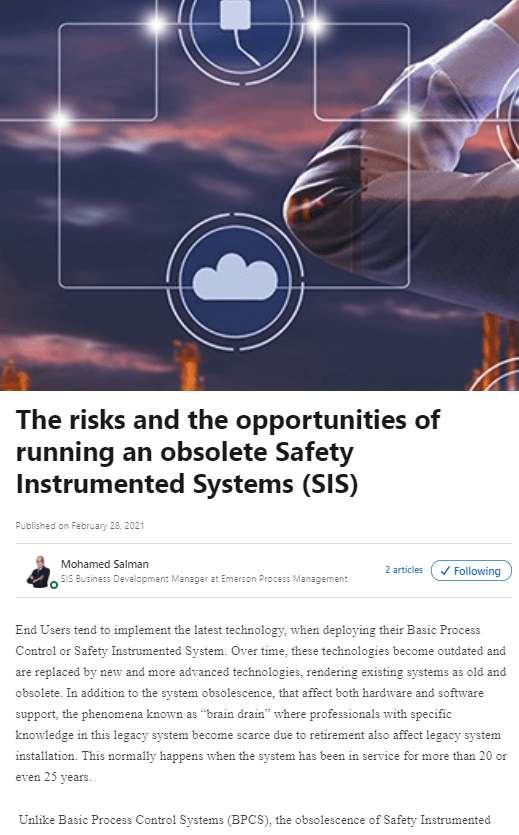 Safety instrumented systems (SISs) are used to reduce risks and bring to process to a safe state in the event of an upset or abnormal condition. Assessing this risk over the lifecycle of the operations is part of the IEC 61511 global safety standard.
Safety instrumented systems (SISs) are used to reduce risks and bring to process to a safe state in the event of an upset or abnormal condition. Assessing this risk over the lifecycle of the operations is part of the IEC 61511 global safety standard.
In a LinkedIn article, The risks and the opportunities of running an obsolete Safety Instrumented Systems (SIS), Emerson’s Mohamed Salman shares his expertise on evaluating the component subsystems in a SIS as they age. Mohamed opens noting that unlike:
…Basic Process Control Systems (BPCS), the obsolescence of Safety Instrumented Systems (SIS) are critical due to the safety functions allocated to the SIS that provides protection to the people, assets and the environment. The safety function of the SIS automatically puts the process into a safe state whenever required or demanded by the process.
Risk mitigation:
…must be quantified by determining the Probability of Failure on Demand (PFD) of the SIS. In addition to the PFDavg, the Architectural Constrains and Systematic Capability must meet the targeted SIL as well, so that the subsystem can be confirmed to meet the targeted SIL.
It’s important to understand the useful lives of these component subsystems:
The PFDavg is calculated using the failure rates data (ʎ) of the subsystem under the evaluation. The failure rate (ʎ) is assumed to be constant during the useful lifetime period of the subsystem…
This useful life defined in ISA TR-84.00.03-2019, Mechanical Integrity of Safety Instrumented Systems (SIS), clause 3.1.26 explains:
The portion of equipment life where the random failure rate can be considered constant.
Mohamad expands on quantifying the performance of the SIS.
The system performance of the SIS must be quantified and demonstrated through the SIL verification process. The SIL Verification uses failure rates of the subsystem which are assumed to be constant during the useful lifetime of the product. Normally the SIS vendor must indicate the useful lifetime of the product for which their published constant failure rate is applicable and can be used to estimate the PFDavg.
Read the full article for more on how digital technologies with advanced diagnostics can help diagnose problems area and improve Mean Time To Repair (MTTR), how to factor in the risk from cyber threats, ways to reduce SIS complexities with modern SIS such as DeltaV SIS.
Visit the DeltaV Safety Instrumented System (SIS) section on Emerson.com for more on the embedded technology to continuously monitor safety devices’ status and diagnose the health of the entire safety loop for greater risk mitigation. You can also connect and interact with safety instrumented system and control system experts in the Control & Safety Systems group in the Emerson Exchange 365 community.





